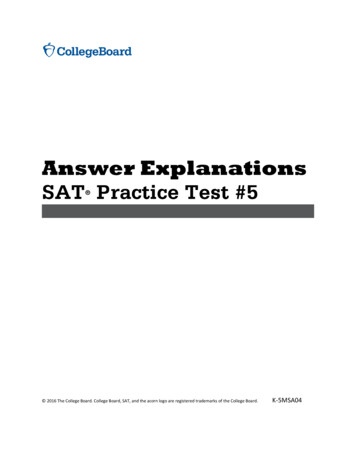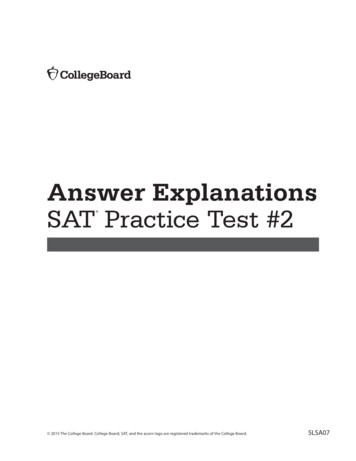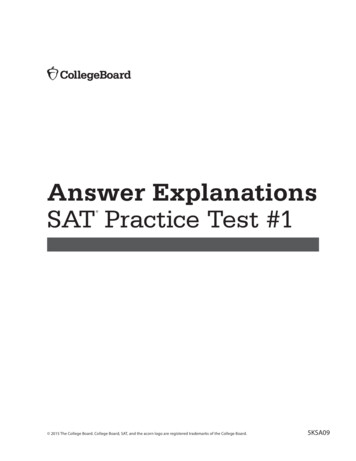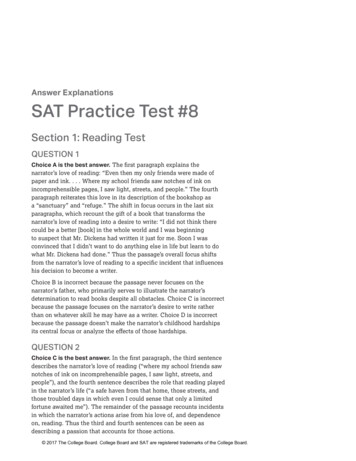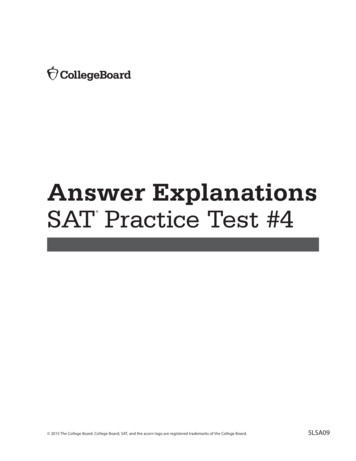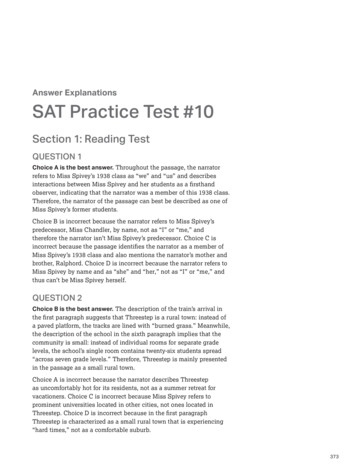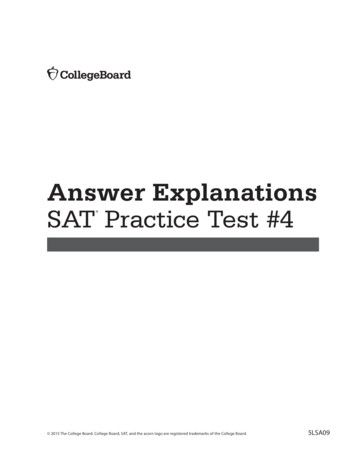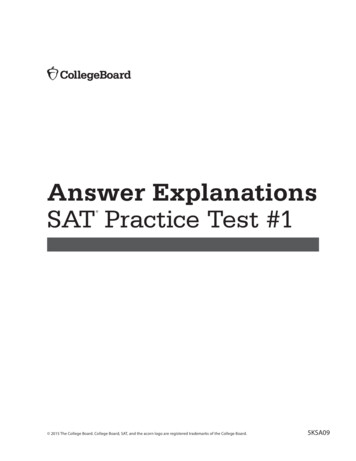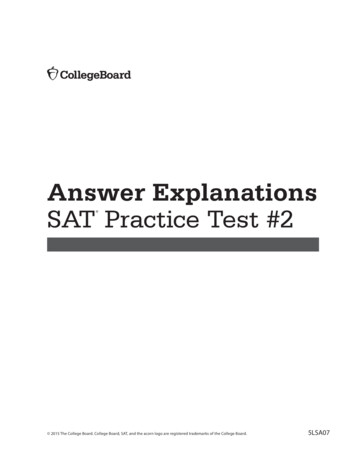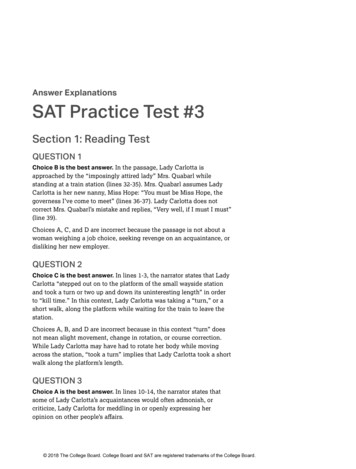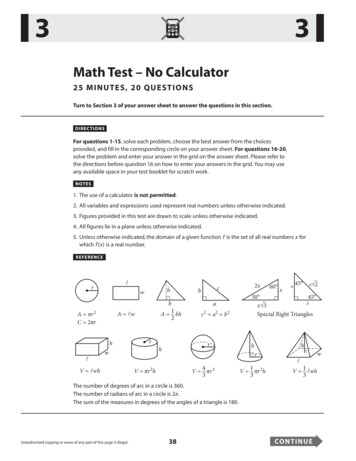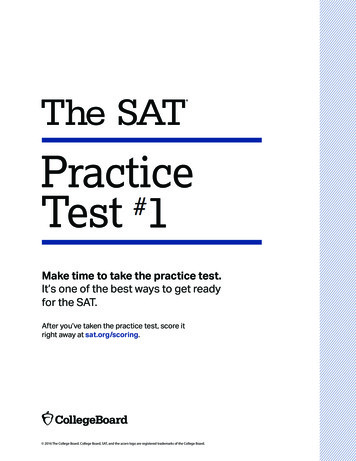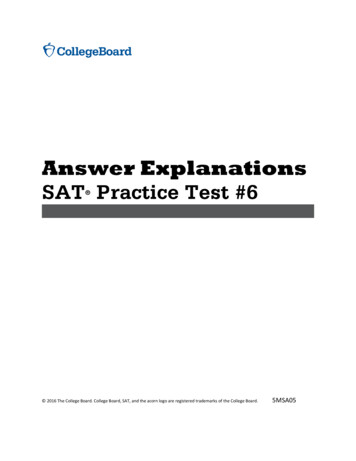
Transcription
Answer Explanations 2016 The College Board. College Board, SAT, and the acorn logo are registered trademarks of the College Board.5MSA05
Answer ExplanationsSection 1: Reading TestQUESTION 1Choice C is the best answer. In the first paragraph the reader is introduced to Nawab, a father of twelvedaughters who feels compelled to make more money to care for his family: “he must proliferate hissources of revenue” (lines 6-7). The remainder of the paragraph focuses on the way Nawab attempts to“proliferate” those income sources by identifying some of the moneymaking schemes Nawabundertakes, including setting up a flour mill and a fish farm and attempting to fix both radios andwatches.Choice A is incorrect because even if the first paragraph does indicate that Nawab is willing to work hardto take care of his family, it does not specifically address how he interacts with his daughtersemotionally. Choice B is incorrect because the first paragraph describes some of Nawab’s activities butnot the specifics of his schedule. Choice D is incorrect because the first paragraph introduces Harouni asNawab’s employer but does not describe his lifestyle.QUESTION 2Choice B is the best answer. The passage states that Nawab earned “more kicks than kudos” (line 16)for his failed attempts at fixing watches. In the context of not doing a job well, this means Nawab wasnot given compliments (“kudos”) for his efforts but complaints (“kicks”) about them.Choices A and D are incorrect because the passage clearly states that Nawab was not successful fixingwatches, which earned him a negative response (“kicks,” or complaints). In this context it would beillogical to suggest that Nawab’s unsuccessful efforts at fixing watches would result in the sort ofpositive response implied by choice A (“thrills”) or choice D (“interests”). Choice C is incorrect becauseeven though “jolts” might be unpleasant, they’re not the kind of negative response one would getinstead of compliments.QUESTION 3Choice D is the best answer. The passage states that Nawab works “like an engineer tending the boilerson a foundering steamer in an Atlantic gale” (lines 26-28) in his attempts to keep his employercomfortable. The author likely uses this image because it highlights the challenging nature of Nawab’swork—work that is described in the next sentence as requiring “superhuman efforts” (line 28).
Choices A, B, and C are incorrect because the author’s use of the image of an engineer working hard ona “foundering steamer” describes the effort Nawab is making in keeping his employer comfortable, notwhat Nawab might be dreaming about, anything to do with tube wells (which are not mentioned in thesecond paragraph), or that Nawab has had many different jobs in his life.QUESTION 4Choice A is the best answer because lines 28-32 show that Nawab is an efficient employee, stating thatdue to his “superhuman efforts,” Nawab is able to keep his employer comfortable, or in almost “thesame mechanical cocoon . . . that the landowner enjoyed in Lahore.”Choice B is incorrect because lines 40-42 describe the actions of Nawab’s employer only and do notaddress the employer’s feelings about Nawab’s work. Choice C is incorrect because lines 46-49 showNawab characterizing himself as an old and ineffective employee, not one who performs his job well.Choice D is incorrect because line 58 addresses the fact Nawab had always lived in his employer’shousehold but not his effectiveness as an employee.QUESTION 5Choice C is the best answer. The main purpose of Nawab’s comments in lines 43-52 is to highlight thelabor and service he has provided for Harouni over the years. Nawab says “there is but one man, me,your servant” to take care of the tube wells on all Harouni’s vast lands and that the extensive work hasresulted in Nawab earning gray hairs on his employer’s behalf.Choice A is incorrect because even though lines 43-52 initially highlight the vastness of Harouni’s lands,those lines primarily focus on Nawab’s dedication and service to Harouni. Choice B is incorrect becauselines 43-52 emphasize not that Nawab is competent and reliable but that Nawab feels he is no longerable to adequately fulfill his duties. Choice D is incorrect because in lines 43-52, Nawab doesn’t say heintends to quit his job, asking instead only for help doing it.QUESTION 6Choice D is the best answer. In lines 61-62, Nawab says to his employer that he “cannot any longerbicycle about like a bridegroom from farm to farm.” In this context, Nawab uses the word “bridegroom”to imply he is no longer a young man who can easily travel such great distances on his bike.Choices A, B, and C are incorrect because in the context of Nawab not being able to bike so far, he usesthe word “bridegroom” to imply that he is no longer young, not that he is no longer in love (choice A),naive (choice B), or busy (choice C).QUESTION 7
Choice B is the best answer. Harouni’s reaction to Nawab’s request for a new motorcycle can be foundin lines 66-68, where the employer is said not to “particularly care one way or the other, except that ittouched on his comfort—a matter of great interest to him.” For Harouni, in other words, the issue ofNawab getting a new motorcycle came down to what was best for Harouni, not what was best forNawab.Choice A is incorrect because in the passage Harouni is said not to be particularly impressed with howhard Nawab works; he cares about the issue of the motorcycle only in regard to its effect on his owncomfort. Choice C is incorrect because Harouni is said to find Nawab’s speech not eloquent but “florid”(line 54), meaning flamboyant or ostentatious. Choice D is incorrect because Nawab does not threatento quit his job but politely asks his employer to “let me go” (line 64).QUESTION 8Choice B is the best answer. The previous question asks why Harouni purchases his employee Nawab anew motorcycle, with the correct answer (that Harouni did so because it was in his own best interest)supported in lines 66-68: “He didn’t particularly care one way or the other, except that it touched on hiscomfort—a matter of great interest to him.”Choices A, C, and D are incorrect because the lines cited do not support the answer to the previousquestion about why Harouni buys Nawab a new motorcycle. Instead, they simply identify the issue(choice A), note that Harouni also gave Nawab money for gas (choice C), and show how the motorcycleaffects Nawab’s side businesses (choice D).QUESTION 9Choice A is the best answer. The passage states that Nawab’s new motorcycle leads to the “disgust ofthe farm managers” (line 74).Choices B, C, and D are incorrect because the passage specifically says Nawab’s new motorcycle leads tothe “disgust of the farm managers,” not their happiness (choice B), envy (choice C), or indifference(choice D).QUESTION 10Choice D is the best answer. The passage specifically states what Nawab considers the greatest part ofhis getting a new motorcycle: “Best of all, now he could spend every night with his wife” (lines 81-82).Choices A, B, and C are incorrect because the passage explicitly states that Nawab believes the bestthing about his new motorcycle is that he can “spend every night with his wife,” not that people startcalling him “Uncle” (choice A), that he is able to expand his business (choice B), or that he is able toeducate his daughters (choice C).QUESTION 11
Choice B is the best answer. The passage states that historically, “newspapers such as The Times andbroadcasters such as the BBC were widely regarded as the trusted shapers of authoritative agendas andconventional wisdom” (lines 27-30). But it goes on to say that “there is a growing feeling . . . that thenews media should be ‘informative rather than authoritative’” (lines 70-73). Together these linesindicate the main purpose of the passage, which is to discuss how people’s perception of the newsmedia is changing from its being an authoritative voice to simply an informative one.Choice A is incorrect because the passage deals with changes in the way news is perceived but does notprimarily focus on the technological changes that may have resulted in those or other changes. Choice Cis incorrect because even if the passage implies that viewers might increasingly believe a journalist’svalues can affect the news stories being produced, it does not provide specific examples of thathappening. Choice D is incorrect because the passage begins with the simple sentence “The news is aform of public knowledge” (line 1) and makes no attempt to refute that claim.QUESTION 12Choice D is the best answer. Although the passage initially states that traditional news authorities wereonce implicitly “trusted” (line 29) regarding the content they produced, it goes on to note that “as partof the general process of the transformation of authority . . . the demand has been for all authority tomake explicit the frames of value which determine their decisions” (lines 33-38). The modern audience,in other words, wants to hear not only the stories a news organization produces but also the values thatform the foundation of that organization’s beliefs.Choices A, B, and C are incorrect because lines 33-38 make clear that the expectation traditionalauthorities now face is the need to “make explicit the frames of value which determine their decisions,”not that they shouldn’t be affected by commercial interests (choice A), that they should work for thecommon good (choice B), or that they should consider the context of public versus private knowledge(choice C).QUESTION 13Choice C is the best answer. The previous question asks what expectation traditional authorities nowface, with the answer being that they must make their perspectives or beliefs clear to the audience. Thisis supported in lines 33-38: “As part of the general process of the transformation of authority . . . thedemand has been for all authority to make explicit the frames of value which determine their decisions.”Choices A, B, and D are incorrect because the lines cited do not support the answer to the previousquestion about what expectation traditional authorities now face, instead contrasting private and publicknowledge (choice A), explaining the complexity of news dissemination (choice B), and providing oneway news has changed in modern times (choice D).QUESTION 14
Choice C is the best answer. In lines 23-25, the passage states that “there is not always commonagreement about what the public needs to know.” In this context, a “common” agreement is awidespread one shared by many people.Choices A, B, and D are incorrect because in the context of something shared by many people, the word“common” implies that it is widespread, not that it is plentiful or abundant (choice A), recognizable toothers (choice B), or normal (choice D).QUESTION 15Choice B is the best answer. Two quotes are provided in lines 43-53, one highlighting the way editorswork differently in modern times due to the demands of the audience and one offering an opinionabout the perceived negative effects of that new reality of news. Those extended quotations wereadded by the authors most likely because they provide concrete examples of how some journalists feelabout modern news dissemination.Choice A is incorrect because the two quotations provided in lines 43-53 are not contradictory: the firstoffers a description of how news editors work differently in modern times, and the second describeshow certain changes might affect news stories or the audience. Choices C and D are incorrect becausethe two quotations illustrate how some feel about the way the dissemination of news might be changingand are not used to either criticize or make suggestions.QUESTION 16Choice A is the best answer. The passage explains that although the major news organizations wereonce considered “trusted shapers” (line 29) of public knowledge, that perception is changing due to the“growing feeling . . . that the news media should be ‘informative rather than authoritative’; the job ofjournalists should be to ‘give the news as raw as it is, without putting their slant on it’; and peopleshould be given ‘sufficient information’ from which ‘we would be able to form opinions of our own’”(lines 70-77). In other words, the audience now wants raw facts about the world, not facts constructedin support of a certain opinion.Choice B is incorrect because the passage presents the public as wanting information without any slanton it, not as wanting only a limited amount of information. Choices C and D are incorrect because thepassage does not specifically identify the public’s feelings about including quotations from authorities innews stories or how they would want journalists to handle private details that the subjects of newsstories do not want revealed.QUESTION 17Choice D is the best answer. The previous question asks what the public is beginning to believe shouldbe avoided in news stories, with the answer being the personal opinions or feelings of journalists. This issupported in lines 70-77: “There is a growing feeling . . . that the news media should be ‘informativerather than authoritative’; the job of journalists should be to ‘give the news as raw as it is, without
putting their slant on it’; and people should be given ‘sufficient information’ from which ‘we would beable to form opinions of our own.’”Choices A, B, and C are incorrect because the lines cited do not support the answer that the modernpublic wants journalists to avoid personal judgments when telling news stories, instead contrastingpersonal or private knowledge with public knowledge (choice A), characterizing how trustedbroadcasters were once viewed (choice B), and explaining how some professional journalists feel aboutthe new reality of the news (choice C).QUESTION 18Choice A is the best answer. In lines 73-75, the passage states the modern belief that “the job ofjournalists should be to ‘give the news as raw as it is, without putting their slant on it.’” In this context,the word “raw” means unfiltered or in its most basic state.Choices B, C, and D are incorrect because in the context of news without any “slant on it,” the word“raw” implies something unfiltered, not something unprotected or uncovered (choice B), severe(choice C), or untried or unproven (choice D).QUESTION 19Choice A is the best answer. The table shows that in 1985, 55% of respondents believed newsorganizations “get the facts straight,” which was the highest percentage for that choice for any of theyears provided.Choices B, C, and D are incorrect because the table shows that the percentage of respondents whobelieved news organizations “get the facts straight” was smaller in 1992 (49%), 2003 (36%), and 2011(25%) than in 1985 (55%).QUESTION 20Choice C is the best answer. The table shows that from 2003 to 2007, the percentage of people whobelieved news organizations “get the facts straight” rose only minimally, from 36 to 39%, while theirperception of the independence and fairness of those organizations changed not at all, remaining at23% and 26%, respectively.Choice A is incorrect because the table indicates viewers’ perceptions of the accuracy of newsorganizations but does not identify how many inaccurate news stories there were in any of the yearslisted. Choice B is incorrect because the number of people who believe news organizations “tend tofavor one side” did not double between 1992 and 2003, rising only from 63% to 66%. Choice D isincorrect because the table shows that between 2007 and 2011, people’s perception of the accuracy ofnews organizations decreased rather than increased, dropping from 39% to 25%.QUESTION 21
Choice C is the best answer. The 2011 data in the table indicate that only 25% of respondents believednews organizations were accurate, 15% believed they were independent, and 16% believed they werefair. Combined, these data support the idea put forth in lines 69-70 that modern audiences arebecoming skeptical of the authority of experts.Choices A, B, and D are incorrect because the 2011 data in the table show the public’s lack of faith in theaccuracy, independence, and fairness of news organizations but do not indicate how politically involvedthat public was (choice A), demonstrate the claims of experts (choice B), or reveal the importance ofviewer mouse clicks in modern news (choice D).QUESTION 22Choice B is the best answer. The first paragraph of the passage identifies and describes “Texas gourdvines” (line 1), but the primary focus of the passage is introduced in the first sentence of the secondparagraph: “In one recent study, Nina Theis and Lynn Adler took on the specific problem of the Texasgourd—how to attract enough pollinators but not too many beetles” (lines 17-20). The remainder of thepassage focuses on describing the purpose, process, and results of the recent research done on thoseTexas gourd vines.Choice A is incorrect because the passage doesn’t focus on the assumptions behind a theory but ratheron the way in which that theory was tested. Choice C is incorrect because the passage does not presentmuch conflicting data; most of it supports the idea there can be too much fragrance for the Texas gourdvine. Choice D is incorrect because the passage explains the procedures used in a study were “’verylabor intensive’” (line 58) but does not present them as particularly innovative.QUESTION 23Choice A is the best answer. The passage says that to test their hypothesis, the scientists “planted168 Texas gourd vines in an Iowa field” (lines 33-34) and then ultimately walked “from flower to flower,observing each for two-minute intervals” (lines 62-63). Because they gathered data by looking at andstudying the plants in question, the scientists’ research is best characterized as relying on directobservation.Choices B, C, and D are incorrect because lines 62-63 make clear that the research emphasized directobservation, not historical data (choice B), expert testimony (choice C), or random sampling (choice D).QUESTION 24Choice D is the best answer. The passage states that by using the smell of their nectar to lure pollinatorslike bees, Texas gourd vines are employing an “’open communication network’” that attracts “’not justthe good guys, but . . . also . . . the bad guys’” (lines 7-10). Because cucumber beetles are then identifiedas some of “the very bad guys” (line 12) as far as the Texas gourd plant is concerned, it can be inferredthat both the beetles and the bees are attracted to the same scent.
Choices A and C are incorrect because they are not supported by the text; the passage states thatcucumber beetles “chew up pollen and petals” (lines 12-13) from the Texas gourd vines but not thatthose vines are their “primary” food source, and the passage does not address any effects, positive ornegative, that cucumber beetles experience as a result of carrying bacterial wilt disease. Choice B isincorrect because the passage states that treating the Texas gourd vines with dimethoxybenzene led to“double the normal number of beetles” (lines 65-66) but that pollinators like bees “did not prefer” (line67) the treated flowers, which implies that cucumber beetles are not less attracted but more attractedto dimethoxybenzene than honey bees are.QUESTION 25Choice C is the best answer. The author indicates that it is reasonable to think that the Texas gourdplants might lure more pollinators if their smell was stronger. This is clear from lines 26-27, which statethat “intuition suggests that more of that aroma should be even more appealing to bees.”Choices A and D are incorrect because lines 26-27 support the idea that it was initially thought thatTexas gourd vines could lure more pollinators through “more of that aroma,” not by lacking an aroma(choice A) or giving off a more varied aroma (choice D). Choice B is incorrect because bees are the onlypollinators specifically discussed in the passage, and there is no suggestion that targeting other insectswould attract more bees.QUESTION 26Choice A is the best answer. The passage explains that as part of their research the scientists “made halfthe plants more fragrant by tucking dimethoxybenzene-treated swabs deep inside their flowers. Eachtreated flower emitted about 45 times more fragrance than a normal one” (lines 35-39). In this context,a flower that was “treated” would be one that was changed or altered.Choices B, C, and D are incorrect because in the context of a flower having a compound likedimethoxybenzene added to it, the word “treated” means changed or altered, not returned to normal(choice B), given (choice C), or kept for future use (choice D).QUESTION 27Choice D is the best answer. In the passage Theis surmises that honey bees were likely repelled not bythe enhanced fragrance of the dimethoxybenzene-treated flowers but “by the abundance of beetles”(lines 71-72) found on them. She was able to make that assumption because the honey bees were ableto choose between both normal flowers and fragrance-enhanced flowers without any beetles on them,because one of the parameters of the research was that “every half hour throughout the experiments,the team plucked all the beetles off of half the fragrance-enhanced flowers and half the control flowers,allowing bees to respond to the blossoms with and without interference by beetles” (lines 45-50).Choice A is incorrect because the passage states only that the scientists observed the bees and beetleson the flowers as soon as they opened (lines 59-61), not both before and after they opened. Choice B is
incorrect because although the passage does state that the experiment only took place during the“August flowering season” (line 35), it doesn’t state that this was a variable in the experiment or had anyeffect on it. Choice C is incorrect because comparing gourds based on the type of pollination is notrelated to the issue of what repelled bees from the fragrance-enhanced plants.QUESTION 28Choice A is the best answer. The previous question asks what Theis and Adler did to allow Theis totheorize that the bees were repelled not by the enhanced fragrance of certain flowers but by theexcessive number of beetles on them, with the answer (they give the bees the chance to visit bothnormal and fragrance-enhanced flowers that did not have beetles on them) being supported in lines 4550: “So every half hour throughout the experiments, the team plucked all the beetles off of half thefragrance-enhanced flowers and half the control flowers, allowing bees to respond to the blossoms withand without interference by beetles.”Choices B, C, and D are incorrect because the lines cited do not support the answer to the previousquestion about what allowed Theis and Adler to theorize that the bees were repelled not by fragrancebut by insects, instead highlighting a variable that didn’t directly address the effect of fragrance on bees(choice B), describing the timing of one of the steps undertaken in the experiment (choice C), anddiscussing an aspect of gourd growth that was not related to the question of why bees may or may nothave wanted to visit fragrance-enhanced flowers (choice D).QUESTION 29Choice A is the best answer. The first six paragraphs (lines 1-64) of the passage introduce a plant (theTexas gourd vine) and its problem (luring enough insects to pollinate it but not too many of those thatwill harm it) and then describe a study undertaken to deal with “the specific problem of the Texasgourd—how to attract enough pollinators but not too many beetles” (lines 18-20). After the specifics ofthat experiment are described in detail, the results are explained and summarized in the seventh andeighth paragraphs (lines 65-84): “What they saw was double the normal number of beetles. . . . Squashbees were indifferent, and honey bees visited enhanced flowers less often. . . . That added up to lessreproduction for fragrance-enhanced flowers” (lines 65-76).Choice B is incorrect because Theis and Adler’s hypothesis (that more fragrance would make the flowers“even more appealing to bees,” line 27) is found in the third paragraph (lines 26-40). Choice C isincorrect because Theis and Adler’s methods are described in the third through sixth paragraphs (lines26-64), not the seventh and eighth (lines 65-84). Choice D is incorrect because the seventh and eighthparagraphs detail the results in an experiment but do not focus on the researchers’ reasoning.QUESTION 30Choice B is the best answer. To be “indifferent” is to be apathetic, or without care or concern. In thecontext of an experiment that tested whether or not insects preferred normally scented flowers or ones
with enhanced fragrance, describing the squash bees as “indifferent” implies they did not care about thescents and were equally drawn to both types of flowers.Choice A is incorrect because “indifference” suggests the amount of concern one has about somethingbut not anything to do with physical capabilities (such as being able to distinguish between the flowers).Choice C is incorrect because “indifference” suggests that one has no preference. Choice D is incorrectbecause the squash bees are said to be “indifferent” to certain flowers based on their fragrance, not onthe number of beetles that may or may not be on them.QUESTION 31Choice B is the best answer. Theis and Adler’s research clearly provided an answer to the question ofwhy there is an upper limit on the intensity of the aroma emitted by Texas gourd plants, as theirexperiment was described as being able to “provide a reason that Texas gourd plants never evolved toproduce a stronger scent” (lines 85-86).Choice A is incorrect because Theis and Adler’s research was not able to show how to increase pollinatorvisits to the Texas gourd vine, as the results of their experiment showed that “pollinators, to theirsurprise, did not prefer the highly scented flowers” (lines 67-68). Choice C is incorrect because Theis andAdler’s research was not able to explain how hand pollination rescued fruit weight, a finding the passagedescribes as “a hard-to-interpret result” (line 83). Choice D is incorrect because the passage neverindicates that the flowers stop producing fragrance when beetles are present.QUESTION 32Choice D is the best answer. The previous question asks what question from among the answer choicesTheis and Adler’s research was able to answer regarding Texas gourd vines. The answer (theydetermined why there was an upper limit to the amount of fragrance produced) is supported in lines 8586: “The new results provide a reason that Texas gourd plants never evolved to produce a strongerscent.”Choices A, B, and C are incorrect because the lines cited do not support the answer to the previousquestion about what Theis and Adler’s research revealed about Texas gourd vines, instead explainingthe goal of the experiment undertaken (choice A), identifying some of the fragrance compounds foundin the plant’s aroma (choice B), and describing results related to hand pollination rather than fragrance(choice C).QUESTION 33Choice B is the best answer. In Passage 1, Lincoln asserts that citizens of the United States should neverbreak the laws of their land, for any reason, because to do so undermines the nation’s values. This isclearly demonstrated when he says, “let every man remember that to violate the law, is to trample onthe blood of his father, and to tear the character of his own, and his children’s liberty” (lines 9-12).
Choice A is incorrect because Lincoln says that bad laws “should be repealed as soon as possible”(line 30), not that breaking the law would slow their repeals. Choice C is incorrect because Lincoln saysthat “there is no grievance that is a fit object of redress by mob law” (lines 36-37) but doesn’t argue thatbreaking the law will lead to mob rule. Choice D is incorrect because in his speech Lincoln doesn’tdiscuss divisions between social groups.QUESTION 34Choice A is the best answer. The previous question asks what Lincoln believes is the result of breakingthe laws, with the answer being that such actions undermine a nation’s values. This is supported in lines9-12: “let every man remember that to violate the law, is to trample on the blood of his father, and totear the character of his own, and his children’s liberty.”Choices B, C, and D are incorrect because the lines cited do not support the answer to the previousquestion regarding what Lincoln contends happens when citizens break the law, instead explainingexactly which groups Lincoln believes should vow to follow the laws (choice B), illustrating how Lincolnbelieves unjust laws should be dealt with (choice C), and stating Lincoln’s belief that no law is everimproved through mob rule (choice D).QUESTION 35Choice D is the best answer. In lines 24-25, Lincoln says, “I so pressingly urge a strict observance of allthe laws.” In this context, the word “urge” most nearly means advocate, because when Lincoln urgespeople to obey the laws, he is pleading in favor of them doing so.Choices A and C are incorrect because in the context of lines 24-25 (“I so pressingly urge a strictobservance of all the laws”), to urge that laws be followed is to advocate for them to be obeyed, not tospeed up such adherence (choice A) or make such adherence necessary (choice C). Choice B is incorrectbecause Lincoln is asking people to follow the laws but not directly causing people to obey them.QUESTION 36Choice D is the best answer. After advocating for citizens “never to violate in the least particular, thelaws of the country” (lines 3-4), Lincoln begins the second paragraph by making another point: “When Iso pressingly urge a strict observance of all the laws, let me not be understood as saying there are nobad laws, nor that grievances may not arise, for the redress of which, no legal provisions have beenmade” (lines 24-28). This sentence is an attempt on Lincoln’s part to make clear what could be amisunderstanding of his position (“let me not be understood”) and to co
Section 1: Reading Test QUESTION 1 Choice C is the best answer. In the first paragraph the reader is introduced to Nawab, a father of twelve daughters who feels compelled to make more money to care for his family: “he must proliferate his sources of revenue” (lines 6-7). The remain
